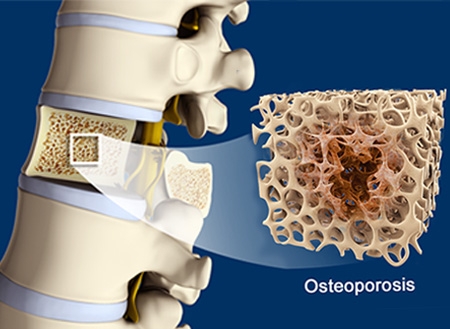When our physicians here at OAW are treating patients, special considerations are made for patients based on their age, gender, and activity level. One of those considerations is in the realm of bone density when treating older patients, specifically smaller-framed, post-menopausal women of caucasian or Asian ethnicity. Most people have heard of osteoporosis, but what exactly are its implications on our orthopedic health?
In general, the bony tissues of the body continually break down and rebuild as a natural process. Osteoporosis is a condition that occurs when the replenishing of new bone fails to keep pace with the loss of old bone. When this occurs, the bones are more susceptible to injury with even the most routine activities because the tissue becomes porous rather than the dense consistency demonstrated in our younger years. This process is exacerbated by hormonal changes and decreased activity. Bones react positively to regular stress. As we age and become more sedentary, the bones naturally undergo less stress and are more likely to lose density. Interestingly, swimmers can also be at a higher risk of experiencing bone density issues due to the amount of time they spend in the water rather than on land. Their bones do not sustain the same stresses as the bones of land athletes. In young people, this is usually negligible and can be combated with regular daily activity.
Signs of osteoporosis can include altered posture, loss of height, back pain, and bony injury with even mild stress such as coughing. The diagnosis is confirmed with bone density testing in the form of a DEXA (dual energy x-ray absorptiometry) scan. Your physician may also order some blood work to check your vitamin D and calcium levels. The presence of osteoporosis can complicate orthopedic care most notably because it increases the risk of sustaining significant fracture with any type of trauma. It can delay bone healing when recovering from these injuries as well. Should any kind of surgical intervention be warranted, the porous nature of the bone can make it more challenging for your surgeon to properly place implants or other types of hardware for fracture fixation.
Once diagnosis is confirmed, treatment options or prevention methods can include oral medications as well as a healthy diet. Oftentimes, orthopedic specialists or primary care providers will recommend supplementing that healthy diet with calcium and vitamin D to promote proper bone health. Initiating a more active lifestyle with increased weight bearing activity can also help to improve bone density. With these considerations, it is possible to combat the effects of osteoporosis and mitigate the risks and preclude complications.
This blog is written by one of our very own-Morgan. She is a certified athletic trainer working in our clinic with our providers each and every day. She obtained a bachelor's degree in athletic training from Carroll University in Waukesha and a master's degree in Kinesiology from Michigan State University.

